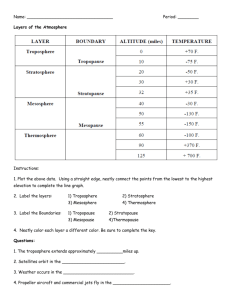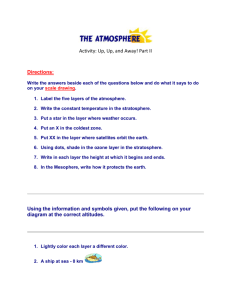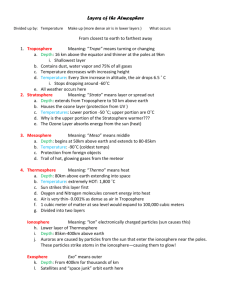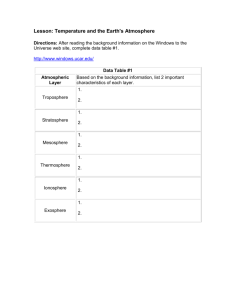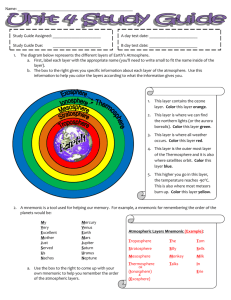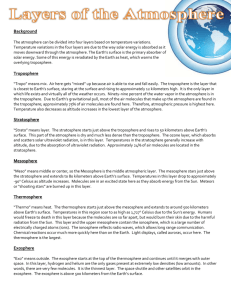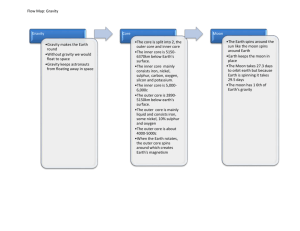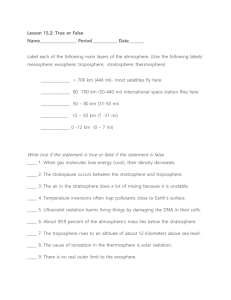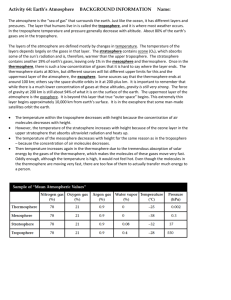Atmopshere Fact Sheet
advertisement
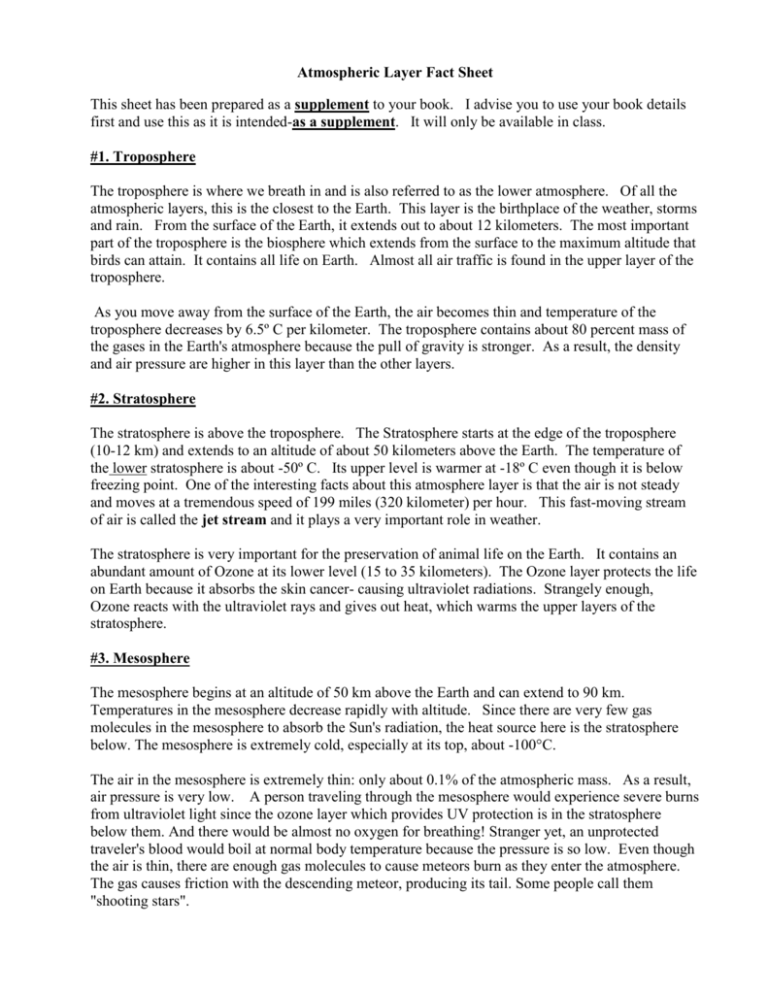
Atmospheric Layer Fact Sheet This sheet has been prepared as a supplement to your book. I advise you to use your book details first and use this as it is intended-as a supplement. It will only be available in class. #1. Troposphere The troposphere is where we breath in and is also referred to as the lower atmosphere. Of all the atmospheric layers, this is the closest to the Earth. This layer is the birthplace of the weather, storms and rain. From the surface of the Earth, it extends out to about 12 kilometers. The most important part of the troposphere is the biosphere which extends from the surface to the maximum altitude that birds can attain. It contains all life on Earth. Almost all air traffic is found in the upper layer of the troposphere. As you move away from the surface of the Earth, the air becomes thin and temperature of the troposphere decreases by 6.5º C per kilometer. The troposphere contains about 80 percent mass of the gases in the Earth's atmosphere because the pull of gravity is stronger. As a result, the density and air pressure are higher in this layer than the other layers. #2. Stratosphere The stratosphere is above the troposphere. The Stratosphere starts at the edge of the troposphere (10-12 km) and extends to an altitude of about 50 kilometers above the Earth. The temperature of the lower stratosphere is about -50º C. Its upper level is warmer at -18º C even though it is below freezing point. One of the interesting facts about this atmosphere layer is that the air is not steady and moves at a tremendous speed of 199 miles (320 kilometer) per hour. This fast-moving stream of air is called the jet stream and it plays a very important role in weather. The stratosphere is very important for the preservation of animal life on the Earth. It contains an abundant amount of Ozone at its lower level (15 to 35 kilometers). The Ozone layer protects the life on Earth because it absorbs the skin cancer- causing ultraviolet radiations. Strangely enough, Ozone reacts with the ultraviolet rays and gives out heat, which warms the upper layers of the stratosphere. #3. Mesosphere The mesosphere begins at an altitude of 50 km above the Earth and can extend to 90 km. Temperatures in the mesosphere decrease rapidly with altitude. Since there are very few gas molecules in the mesosphere to absorb the Sun's radiation, the heat source here is the stratosphere below. The mesosphere is extremely cold, especially at its top, about -100°C. The air in the mesosphere is extremely thin: only about 0.1% of the atmospheric mass. As a result, air pressure is very low. A person traveling through the mesosphere would experience severe burns from ultraviolet light since the ozone layer which provides UV protection is in the stratosphere below them. And there would be almost no oxygen for breathing! Stranger yet, an unprotected traveler's blood would boil at normal body temperature because the pressure is so low. Even though the air is thin, there are enough gas molecules to cause meteors burn as they enter the atmosphere. The gas causes friction with the descending meteor, producing its tail. Some people call them "shooting stars". #4. Thermosphere The next layer is the thermosphere, which is also referred to as the upper atmosphere. This layer begins at 85 to 100 kilometers above the surface of the Earth to the space. The temperature in the thermosphere increases and it can be higher than 1,500º C because there is nothing insulating the air from the Sun’s heat energy. The air in the thermosphere would feel cold though because the molecules of nitrogen and oxygen which absorb the Sun's energy are so far apart that the heat concentration is ineffective. This layer is divided in two sub-layers, the ionosphere and the exosphere. Ionosphere The ionosphere contains electrically charged molecules of the oxygen, nitrogen and other elements which reflect the radio waves back to the Earth and enables the long distance communication. The ionosphere stretches from 80 to 550 kilometers above the Earth’s surface. When solar activity increases (more sun spots or storms), the number of charged particles in the ionosphere increases. This disturbs any satellite and radio communication wave. This is also responsible for auroras which are also called “Northern Lights”. The more solar activity there is the more spectacular an aurora will be. Exosphere The outermost layer of the atmosphere is the exosphere. There is no real outer limit to the exosphere. If you continued traveling farther out from the Earth, the gas molecules would finally become so scarce that you would be in outer space. There is so little gravity holding gas molecules in the exosphere that they sometimes escape into outer space.

